The black dragon hibiscus is a plant worth having on display for onlookers to envy. Its deep, reddish purple, twisted yet wavy and lightly striped blooms are as aesthetically pleasing as flowers can come.
However, growing one of these types of plants requires patience as they grow at a reasonably slow rate. Furthermore, they begin to grow sideways once they reach the 18-inch mark.
So, knowing how to grow black dragon hibiscus while ensuring that your pruning game is on point is essential. Optimizing their conditions will ensure they grow to be the masterpiece you have always wished for.
This article will show you what it takes to grow a black dragon hibiscus with minimal fuss.
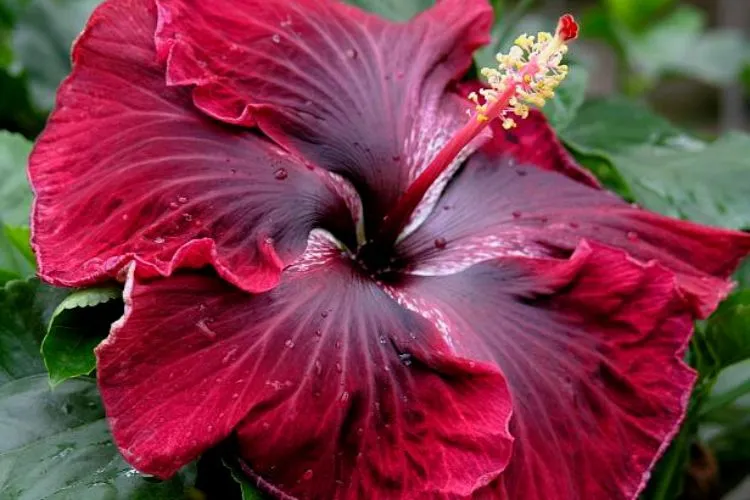
Table of Contents
How to grow black dragon hibiscus (Easy Guide)
When you look at the intricate details of a hibiscus, such as its stigma and petals, you can feel confident to conclude that it would be a difficult plant to grow and nurture. In contrast, the degree of difficulty in doing so is quite low.
The hardest part about cultivating a black dragon hibiscus is the precise time it takes. This hardy perennial takes around 2-3 years to fully mature from seed.
As long as all the growing conditions are met, the rest of the time will be spent maintaining until maturity.
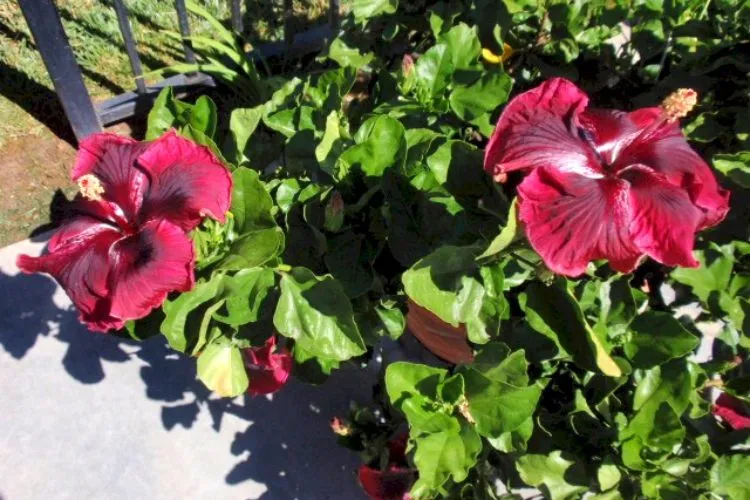
Let’s dive in and look at how to grow black dragon hibiscus, including when, where, how and some simple maintenance guidelines to make sure that you give it the best chance at surviving and thriving.
Things Needed
- 3-4” (7-10cm) diameter pots for germination
- 10” (25 cm) diameter pots for growing
- 90% coco peat and 10% Organic compost for germination
- Well draining potting soil improved by organic matter mixed with perlite or vermiculite
- Nursery sized black dragon hibiscus plants
- Watering can or soft pouring hose, as well as a water supply
- Simple planting tools such as a spade, garden fork and/or pruning shears (once established)
Growing Conditions of Black Dragon (same as growing any other hibiscus)
Planting and Flowering
The best time of year to plant is early spring (March in the Northern Hemisphere, September in the Southern Hemisphere). This will allow them to bloom between July-October (Northern) and January-April (Southern)
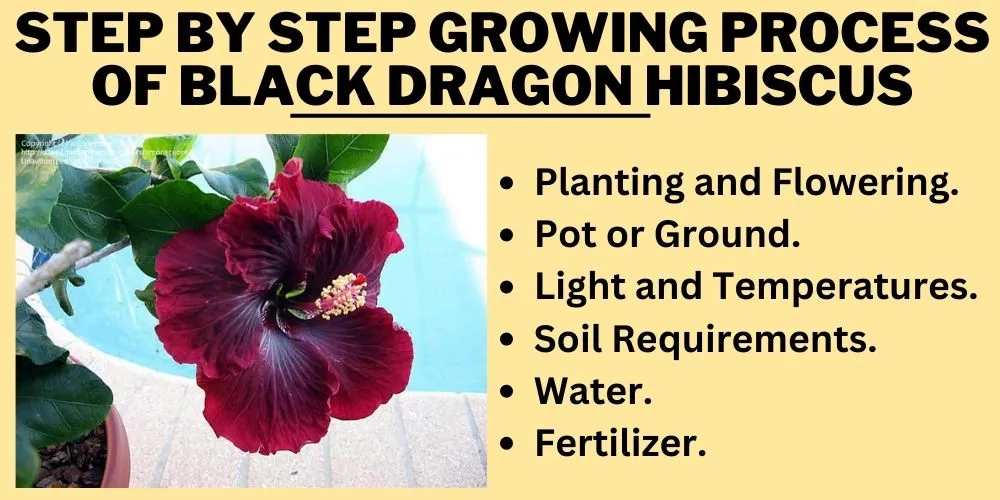
Pot or Ground
The hibiscus can easily be grown in a pot or the ground. However, they are more commonly grown in pots to assist with light adjustments, as pots are much easier to maneuver around. The root ball is wider than deep, so choose a pot accordingly.
We have found that a 10” (25 cm) diameter pot/container is perfect for starters and established plants. That way, they won’t require repotting for quite some time, if ever. Try to use a pot with adequate drainage to avoid pooling which, of course, leads to root rot and other issues that can snowball.
Light and Temperatures
Hibiscus plants love full sun but may require shade if afternoon temperatures exceed more than their comfortable median. 6 hours of full sun per day is ideal. These plants can grow in the shade, but such conditions can not only stunt growth but also produce underdeveloped flowers as a result.
They thrive best in temperatures between 60-85°F (15.5-29.5°C). When the mercury drops below 50°F (10°C), growth and blooming can stop altogether and produce smaller, more deformed flowers. Below freezing temperatures will cause the plant to die.
If it does get cold, it’s best to move a plant like this indoors, where it is safe from the elements. On the other end of the scale, extreme heat can cause wilting, drying and eventually death to this heat-sensitive plant.
Soil Requirements
All hibiscus plants require well-draining, lightweight soil such as loam or sandy loam. We recommend blends that include standard potting mixes, rich organic matter such as compost, and perlite or vermiculite to assist with aeration.
These plants thrive best in slightly acidic soil with a preferred pH range of between 6.5-6.8. The acidity of the soil can be improved by adding peat moss. Always test the pH once adding ingredients and adjust accordingly. Spreading some mulch around the base of the hibiscus can improve water retention in areas that may be a little drier.
Water
Firstly, it’s important to ensure that the growing containers have adequate drainage holes. Excess watering, overwatering and/or pooling can cause big headaches when growing any species of hibiscus. These plants are thirsty and should be watered accordingly.
However, aim to keep them moist without being soggy. Ensure that the top inch has enough moisture, then let it completely dry out before watering again. Depending on the growing location and its conditions, such as dryness, warmth, etc., you may need to water daily.
These plants require minimal moisture during winter as they become dormant. Planting near a pond or wetland area can reduce the need for water frequency.
Fertilizer
Organic plant foods such as fish emulsion or seaweed extract will keep your plants happy and healthy, producing abundant, beautiful blooms. Use a half-strength solution just before the blooming period begins and feed regularly until they stop producing flowers (once every 2 weeks)
Planting Tips for Black Dragon Hibiscus
Germination
- Scratch the seeds coating and soak for 8 hours to help the sprouts penetrate the shell.
- Place seeds in a warm, sunny location such as a window sill or under lights 75°F (24°C)
- Sow them ¼ inch deep to 3-4” pots with 90% coco peat to 10% Organic compost mix.
- Allow 2-3 weeks for them to become seedlings.
- Harden before transplanting.
Growing
Transplant the seedlings to their larger pots, using the well-draining, organic, loamy blend. Water more vigorously over the first 2- 3 weeks to establish the roots. Once they have grounded, cut back the watering to once a week.
Maintenance
Hibiscus takes a good 2-3 years to fully mature. Watering, fertilizing and repotting should be the main focus during the in-between time.
Replaying once a year is advised to replenish the soil and its nutrients. Also, to flush out any possible insects, dead organic matter and debris.
These plants can handle being pruned right back during the winter months. After flowering, aim to remove any dead, dying, damaged or diseased branches, stems or limbs to improve the overall circulation of the plant.
You want these plants to look neat as the beautiful blooms should be the main focus.
What is the best way to grow a hibiscus?
We recommend growing hibiscus plants in a wide based pot or container. They are sensitive to extreme heat and chills, so ensuring the option to maneuver them around is essential.
Even heavy rains and howling winds can cause major issues for a plant like this.
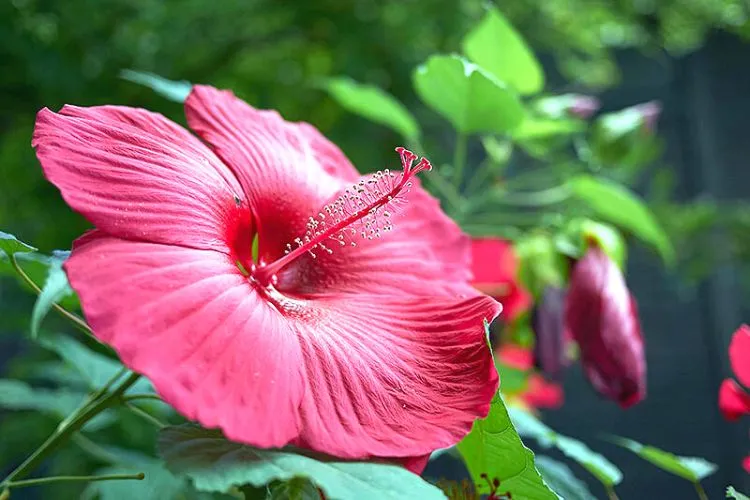
Pots or containers aren’t the be-all and end; they can also be grown in the ground under the right growing conditions.
If the location temperature allows, try adding your black dragon hibiscus alongside ponds, streams, dams or other waterways to improve the surrounding soil condition and minimize the need for frequent watering.
Not only do they look amazing, but they also attract some happy garden friends, such as hummingbirds and butterflies.
These 2 protective specimens love munching on pesky insects such as ants, aphids, fruit flies, gnats, weevils, beetles, mites and mosquitoes. It all comes down to personal choice and or locational conditions.
Does hibiscus grow well in pots?
Hibiscus grow extremely well in pots. The beauty of growing them this way can move them around to give the plants the best growing conditions possible. They prefer full sun, and obtaining that sun every day is often not easy.
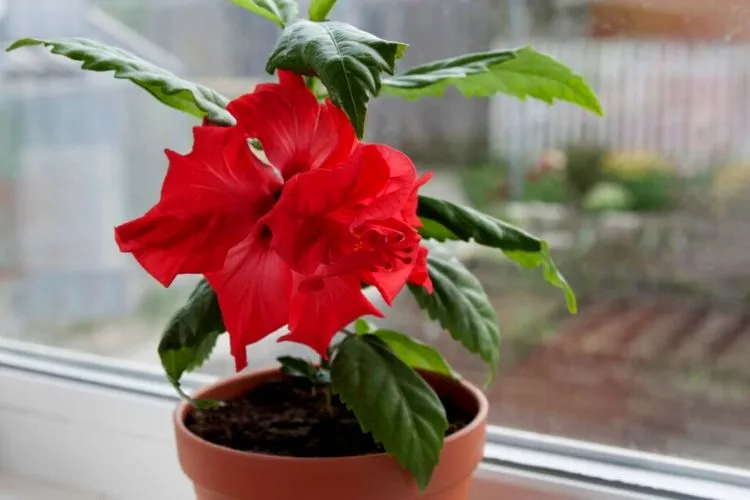
We even go as far as to recommend using a trolley bottom to allow the pots to be pushed or rolled around. This avoids breaking your back and scraping any surface areas.
As long as the pots have adequate drainage and have been prepared with good quality, well draining soil, your hibiscus plant will thank you for it by producing outstanding blooms.
Frequently Asked Questions (FAQs)
Should I remove dead flowers from the hibiscus?
Regular maintenance is great practice for plants such as the hibiscus. Removing dead headed flowers not only freshens up and improves the overall look of the flower, but it also helps it redirect energy to newer blooms. This will ensure the plant’s overall health is of high priority.
What fertilizer does hibiscus like?
Hibiscus prefers fertilizers with a medium level of Nitrogen (N), a low level of Phosphorus (P) and a high level of Potassium (K), e.g., 10-5-20 (N-P-K) in a great ratio.
Is vinegar good for hibiscus plants?
Vinegar can help unlock vital nutrients within the soil by increasing the acidity around the roots. Apple cider vinegar has produced great results, but plain clear household vinegar can also work. Simply mix 1 cup of vinegar with 1 gallon of water and apply at the roots. Never spray or apply directly onto the flowers or surrounding areas. This method can also help to keep pests such as aphids away.
How long does it take for hibiscus to grow full size?
If grown under optimal conditions, a hibiscus can grow to full maturity in around 2-3 years. The blooms are delicate, so placement is of the highest priority, especially when the possibility of being subject to extreme heat, chills and winds is an issue.
Is Epsom salt good for hibiscus?
Much like using vinegar, epsom salts can also help to alter the acidity of the soil in which a hibiscus plant is growing. Apply 1 tablespoon per gallon of overall pot size around the base of the plant. Some growers mix with fertilizer and use it with their monthly feeding routine.
Can I use Miracle Grow on hibiscus?
Miracle Grow is a great product to help produce abundant, healthy blooms. This product will help keep the plant fed for upto 3 months and works almost instantly. The solution may need to be halved if your plant is in its early stages of growth.
Conclusion
Growing a black dragon hibiscus is surprisingly easy. Like all hibiscus, their sensitive flowers are the only tricky aspect to keep in mind. They need to be protected from extreme heat, chills and winds. The best growth method is in containers so they can easily move around.
Although, with the right location, they can also thrive on the ground. We hope this article has been helpful, and we look forward to seeing you next. Happy growing!


